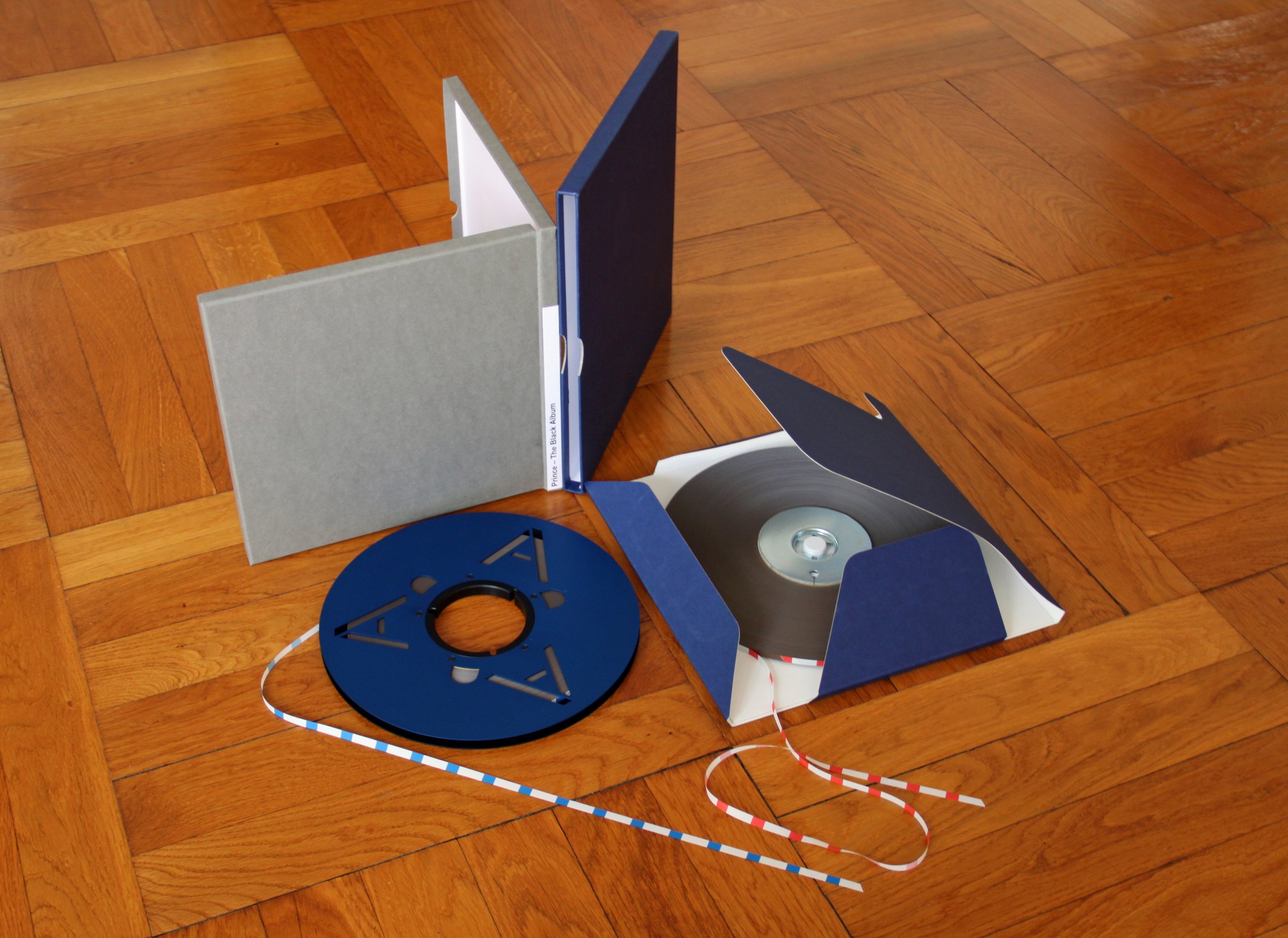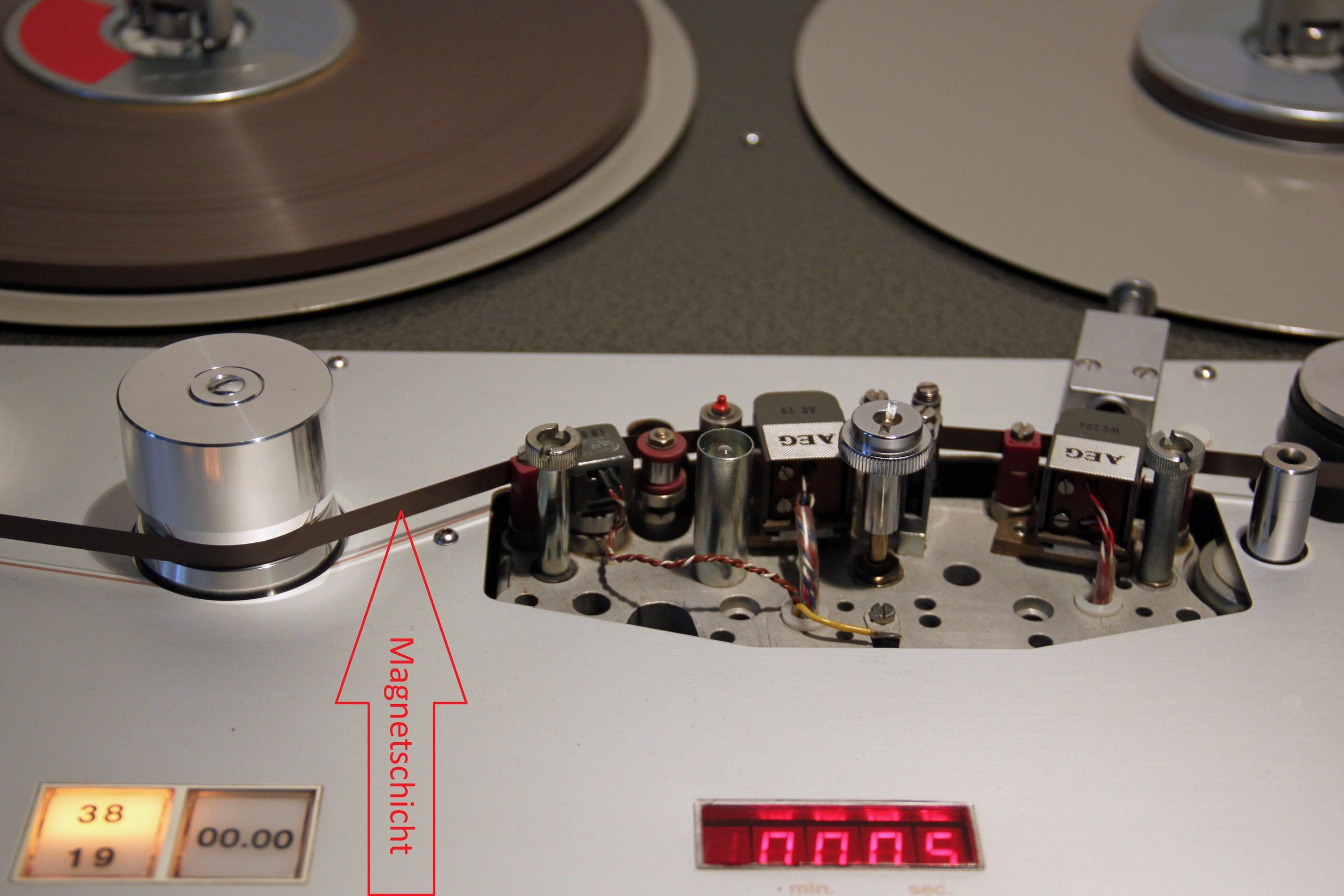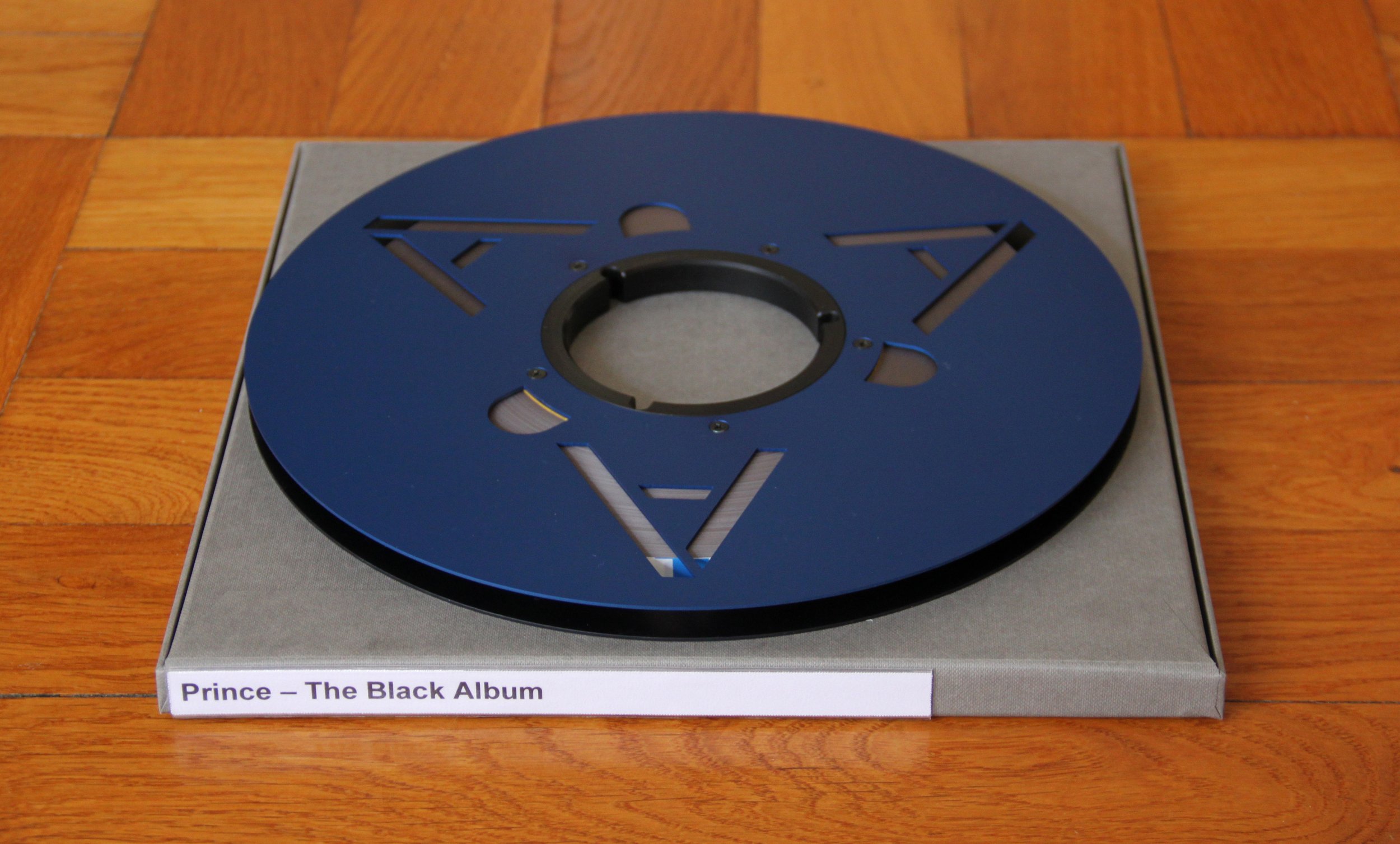Care of audio tapes
Defects in used audio tapes can usually be seen at first glance: Chipped and bent tape ends, poorly wound tape layers, storage defects such as mold and mildew stains, bent metal reels, no information about the recording. Listening reveals copy effects between layers, erased sectors or stuck tape areas. When I started writing this article, I thought it would be done with a few lines. In the meantime it has grown into a compendium, with the goal that even the professional can discover one or two helpful things.
History of the audio tape
The engineer Oberlin Smith from Bridgeton, USA, conducted his first experiments in magnetic sound recording in 1878 and published his invention ten years later in the trade magazine "The Electrical World". The first functioning magnetic recording devices using steel wire were introduced in 1898 by the Danish inventor Valdemar Poulsen. The magnetic tape was invented in Germany. In 1928, paper specialist Fritz Pfleumer developed the first 16 mm wide paper tape coated with iron powder. AEG, one of the world's largest electrical corporations at the time, tested the development and contacted BASF in 1932. This led to the development of the magnetically coated plastic tape in 1934. At the "12th Great German Radio Exhibition" in Berlin (Germany) in 1935, the new tapes were presented together with the AEG magnetophone K1.
After 1945, audio tapes for home and studio use were standardized to a uniform width of ¼ inch (6.35 mm). The triumph of audio tapes (including the compact cassette and other formats) gained more and more importance from the 1970s and lasted for about 20 years. Digital media began their triumphant advance in parallel with the invention of the CD from the mid-1980s onwards, and with the spread of the CD-ROM from the early 1990s onwards, brought the magnetic recording media into very serious trouble. Major tape manufacturers included Agfa, Ampex, Shamrock, BASF, EMTEC, Maxell, Fujifilm, Philips, Scotch, Sony, and TDK. Gradually, the manufacturers of audio tapes either went into decline or were renamed several times: in 1997, BASF Magnetics became EMTEC Consumer GmbH, which went bankrupt in 2003. The machines used to produce the audio tapes according to the original BASF and EMTEC requirements went to RMG International in the Netherlands. In 2012, the RMG plant was closed and production was moved to Pyral in France. In 2015, Mulann, with its RTM (Recording The Masters) brand, acquired the audio tape production facilities, allowing production to continue with the original BASF and AGFA recipes. RTM tapes are still available today. In the USA, AMPEX became the Quantegy brand, which soon disappeared completely from the market. Currently, the company ATR Magnetics is active in the USA.
Storage and archiving of tapes
It should be absolutely clear that magnetic tapes should never be stored in the vicinity of strong magnetic fields, even for short periods. These include degaussing coils, speaker magnets, transformers, power supplies, and also pin boards with magnets. Otherwise, the tapes will be partially erased. This makes the sound recordings completely unusable.
Tapes should be stored in boxes made for this application in a vertical position. Open tape reels that are not supported in the middle by a special holder in the archive box stand flat and should therefore be stored "hanging" in the box by means of a special core holder. Horizontal tape reels (whether with or without a spool) can flow slowly downwards under irregular deformation, i.e. form a bulge. With luck, these can be reused after rewinding if they are not glued down.
The layers of the windings should be as exactly on top of each other as possible. A tape reel protects the tape from external damage to the tape winding. This is also inside the reel, because of the "air" between the plastic or metal boundaries and the tape, in principle a "loose tape winding". When archiving tapes whose layers do not overlap neatly, the material can become distorted, resulting in an incomplete rest on the sound head during playback. Lyres or sound fluctuations can be the result.
For archiving, a stable temperature below 20°C and a humidity of less than 40% is favorable. Cellars and attics that are exposed to temperature and humidity fluctuations are not suitable for storage: mildew or mold growth as well as substances diffusing from the tape material are to be expected, which usually renders the tapes completely unusable. According to ISO 18923:2000, a temperature of 8°C at 25% humidity is recommended.
Labeling tape cartons
When archiving, professionally labeled cartons give a nice overview. The LABELFIX system consists of a sturdy, transparent plastic rail that is glued to the back of the carton. The enclosed perforated paper strips can be printed. They are inserted into the glued-on transparent rails and can be replaced at any time.
Layer position and copying effect
The terms "international" or "German" layering mean that the tape is wound with the magnetized side facing in or out.
On a machine with an international layer, such as a Revox B77, the tape heads face away from the reels. The magnetic layer of the tape is on the inside of the tape reel. In the German layer position, the magnetic layer is on the outside of the tape reel. In corresponding tape recorders, such as the Telefunken M15A, the tape heads then face toward the reel bases. These tapes are mainly run as open tape reels with an "AEG reel core" or "bobby"; i.e. without a tape reel.
One advantage of the German layered system is that the magnetized side of the tape has to run over fewer rollers and guides on the machine, and is thus treated with less care. To play a tape on the other machine, it must be rotated 180°. Careful and careful handling is highly recommended here to avoid frayed edges or unsightly wraps that stress the tape. Please remember that channel 1 (left) and channel 2 (right) are reversed during this reversal.
Also important is the correct storage of tapes with regard to the copying effect. Content copies from one layer to the next. The thinner the tape material, the lower the copy attenuation. A distinction is made between pre-echo and post-echo. To prevent the annoying pre-echo from occurring, a distinction is made according to the layer ply when storing wound tapes to avoid this effect:
In the case of the international layer, one archives pre-wound ("on end" or "tailed out"). Disadvantage: Such a tape must then be rewound before each playback.
With the German layer, it is the other way around: these tapes are stored rewound ("to the beginning"). This has the advantage of being able to access the recording quickly.
The annoying pre-echoes fall into the music signal in each case and thus become hardly perceptible, because the copied-through level is much smaller than the level of the useful signal, which covers it.
Different tape material
When it comes to the thickness of the tape, there are four categories:
Triple reel tape (hobby range): Tape thickness 18 µm: Approx. three times the coil capacity of normal tape. It is very susceptible to stretching, tearing and buckling.
Double play tape (hobby range): Tape thickness 25 µm: Twice the coil capacity of normal tape. It is also susceptible to stretching, tearing and buckling.
Long play tape (upscale hobby range): Tape thickness 35 µm. 1.5 times the coil capacity of normal tape: it is less susceptible to stretching, tearing and buckling.
Normal tape (studio range): Tape thickness 50 µm. Comfortable cutting and gluing with high mechanical strength.
My recommendation: Better spend money on better tape material instead of constantly having the trouble with the problems described above!
Spool sizes and tape running times
The different reel sizes hold more or less tape material, depending on their diameter and on the thickness of the tape material used. Comfortable diameters are 26.5 cm (for example Revox A77, B77, PR99, Studer A807) or 30 cm (for example Studer A810, Telefunken M15A). On the latter reel you get 1000 m of normal tape with a playing time of 44 minutes at a speed of 38 cm/s, which corresponds to the production length of many records. In comparison, the playing time of 34 minutes with 762 m normal tape is suboptimal, because with it two tapes, reels and archive boxes are always needed for a record. I have deliberately refrained from going into detail about all tapes here. This would go beyond the scope of this article.
Erase tape, fresh tape and splices
Factory-fresh material is referred to as fresh tape in radio and recording studio applications. Recorded tapes that have been erased are called erase tape. When reusing formerly recorded tapes, it should be noted that in some cases, despite careful erasure, the original recording becomes faintly audible again under the new recording as the archiving period progresses.
Tape splices can tear during playback due to aging of adhesives. If these are between two titles, which I always recommend when tapes are pieced, a small piece can be cut off and re-taped.
Adjusting and measuring tapes
There is always a correlation between a well calibrated tape machine and the tape material used. In contrast to other media such as the record with all the setting and adjustment possibilities of the pickup, tone arm, turntable, cabling and phono stage, it is almost irrelevant with well preserved tape machines how old or from which manufacture they originate: If they are mechanically and electrically well adjusted, tapes can be played back with equally good electroacoustic values.
Measuring tapes must always be purchased for the respective tape speed and always follow the rules of the playback adjustment part, such as this test tape:
Reference level part 1000Hz 0dB, 120 seconds
Adjustment part 10 000Hz -10dB, 120 seconds
Bias short test part 1000/10 000Hz -20dB
Detailed frequency response part 31,5- 18 000 Hz with announcements, a repetition without announcements and a stepless sliding tone part
The recording part is not performed with an adjustment tape, but always with the tape material provided for this purpose.
Care and repair of tapes
With many older tapes and tapes that have been stored for a long time, the coatings can become attached or detached and recombine. This can get to the point where the material can barely be unwound from the spool. I have given up baking or shock freezing old longplay tapes because the layers could be unwound afterwards, but the guide parts and sound heads of the tape machine were usually so stubbornly stuck together that removing the well adhering and lubricating material degenerated into hours of fiddling. Often there is hardly anything left of the original material in terms of sound, so it is worth considering buying the tracks on vinyl, because sonically better than from the sorry tape material and often cheaper.
The best tape care is rewinding at least once a year. Even better is to listen to the tapes regularly! Machines like a Studer A807 have an archive function. Here, rewinding is done at half speed under an optimal tape tension.
Proposal for the data archive of tape copies
In order to be sure for one's own future or even for "posterity" what was recorded in the past, it makes perfect sense to make a note of as much data as possible:
Origin of the recording (medium, source, quality, ...), production label of a master tape copy ...
Recording date
Number of reels per recording (tape 1 of 2, tape 2 of 2, ...)
Recording speed or color matching leader tape
Layer position, number of tracks, (separation track)
Equalization NAB / CCIR
Recording level
Recording device
Tape type (e.g. SM 468), if possible with batch designation
Artist
Title
Last listening or rewinding date
Leading and trailing tape (identification tape)
The practical and beautiful idea of providing audio tapes with a leader and leader tape is often neglected. The colors of these tapes, which are quite still available on the market, are listed below. Leading and trailing tapes offer several advantages:
One can immediately see whether the tape has been stored forward or rewound.
If kinks occur during threading or storage, they can be cut off without touching the actual tape.
During forward and rewinding, the magnetized material is protected: When the tape hits parts of the tape machine by trailing spools, neither the magnetic layer nor the beginning or end of the tape are destroyed.
What used to be called the specifications can be taken from the technical guidelines of the Institute for Broadcast Technology: The identification tapes should be 1.5 m to 2 m long. When affixing them, care must be taken to ensure that the color imprint of the identification tape matches the layer side of the tape.
Speed | Marking | Type of recording | Position
9.5 cm/s | Gray | Mono | Start of Tape
9.5 cm/s | Gray - White | Stereo Start of tape
19.05 cm/s | Blue | Mono | Start of Tape
19.05 cm/s | Blue - White | Stereo | Start of tape
19.05 cm/s | Blue - White - Black - White | Stereo + telcom c4 | Start of tape
38.1 cm/s Red | Mono | Start of tape
38.1 cm/s | Red - White | Stereo | Start of tape
38.1 cm/s | Red - White - Black - White | Stereo + telcom c4 | Start of Tape
76.2 cm/s | White | Mono | Start of tape
76.2 cm/s | White - Black | Stereo | Start of band
All Yellow Mono and stereo Separation + end







